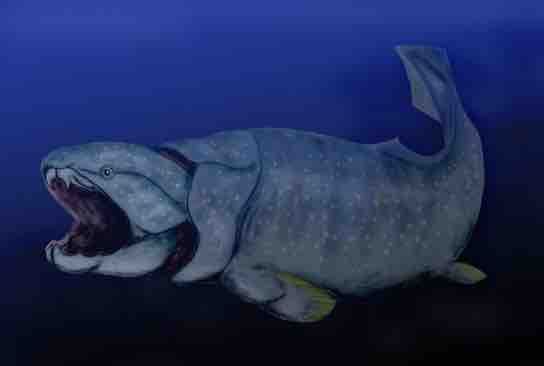Gnathostomes: Jawed Fishes
Gnathostomes or "jaw-mouths" are vertebrates that possess jaws. One of the most significant developments in early vertebrate evolution was the development of the jaw, which is a hinged structure attached to the cranium that allows an animal to grasp and tear its food. The evolution of jaws allowed early gnathostomes to exploit food resources that were unavailable to the jawless animals. In early evolutionary history, there were gnathostomes (jawed fishes) and agnathans (jawless fishes). Gnathostomes later evolved into all tetrapods (animals with four limbs) including amphibians, birds, and mammals.
Early gnathostomes were jawed fishes that possessed two sets of paired fins, which increased their ability to maneuver accurately. These paired fins were pectoral fins, located on the anterior body, and pelvic fins, on the posterior. The evolution of the jaw combined with paired fins permitted gnathostomes to expand from the sedentary suspension feeding of jawless fishes and become mobile predators. The gnathostomes' ability to exploit new nutrient sources led to their evolutionary success during the Devonian period. Two early groups of gnathostomes were the acanthodians and placoderms , which arose in the late Silurian period and are now extinct. Most modern gnathostomes belong to the clades Chondrichthyes and Osteichthyes.

Placoderms
Dunkleosteous was an enormous placoderm from the Devonian period, 380–360 million years ago. It measured up to 10 meters in length and weighed up to 3.6 tons. As gnathostomes, they were more mobile and could exploit more food resources than the agnathostomes.
Chondrichthyes: Cartilaginous Fishes
The clade Chondrichthyes consists of sharks, rays, and skates, together with sawfishes and a few dozen species of fishes called chimaeras, or "ghost," sharks . Chondrichthyes are jawed fishes that possess paired fins and a skeleton made of cartilage. This clade arose approximately 370 million years ago in the early or middle Devonian.

Hammerhead shark
Hammerhead sharks tend to school during the day and hunt prey at night. As members of Chondrichthyes, their skeletons are composed of cartilage.
Most cartilaginous fishes live in marine habitats, although a few species live in fresh water for part or all of their lives. Most sharks are carnivores that feed on live prey, either swallowing it whole or using their jaws and teeth to tear it into smaller pieces. Shark teeth probably evolved from the jagged scales that cover their skin called placoid scales. Some species of sharks and rays are suspension feeders that feed on plankton.
Sharks have well-developed sense organs that aid them in locating prey, including a keen sense of smell and electroreception. Organs called ampullae of Lorenzini enable sharks to detect the electromagnetic fields that are produced by all living things, including their prey. Only aquatic or amphibious animals possess electroreception. Sharks, together with most fishes and aquatic and larval amphibians, also have a sense organ called the lateral line, which is used to detect movement and vibration in the surrounding water. It is often considered homologous to "hearing" in terrestrial vertebrates. The lateral line is visible as a darker stripe that runs along the length of a fish's body.
Rays and skates comprise more than 500 species and are closely related to sharks. They can be distinguished from sharks by their flattened bodies, pectoral fins that are enlarged and fused to the head, and gill slits on their ventral surface. Like sharks, rays and skates have a cartilaginous skeleton. Most species are marine and live on the sea floor, with nearly a worldwide distribution.
Osteichthyes: Bony Fishes
Members of the clade Osteichthyes, also called bony fish, are characterized by a bony skeleton. The vast majority of present-day fish belong to this group, which consists of approximately 30,000 species, making it the largest class of vertebrates in existence today.
Nearly all bony fish have an ossified skeleton with specialized bone cells (osteocytes) that produce and maintain a calcium phosphate matrix. A few groups of Osteichthyes, such as sturgeons and paddlefish, have primarily cartilaginous skeletons, but retain some bony elements. The skin of bony fish is often covered by overlapping scales. Skin glands secrete mucus that reduces drag when swimming and aids the fish in osmoregulation. Like sharks, bony fish have a lateral line system that detects vibrations in water. All bony fish use gills for gas exchange. Water is drawn over gills that are located in chambers covered and ventilated by a protective, muscular flap called the operculum. Many bony fish also have a swim bladder, a gas-filled organ that helps to control the buoyancy of the fish.
Bony fish are further divided into two extant clades: Actinopterygii (ray-finned fish) and Sarcopterygii (lobe-finned fish) . Actinopterygii, the ray-finned fish include many familiar fish, such as tuna, bass, trout, and salmon, among others. Ray-finned fish are named for their fins that are webs of skin supported by bony spines called rays. In contrast, the fins of Sarcopterygii are fleshy and lobed, supported by bone. Although most members of this clade are extinct, living members include the less-familiar lungfishes and coelacanths . Early Sarcopterygii evolved into modern tetrapods, including reptiles, amphibians, birds, and mammals.

Actinopterygii and Sarcopterygii
The (a) sockeye salmon (Actinopterygii) and (b) coelacanth (Sarcopterygii) are both bony fishes of the Osteichthyes clade. The coelacanth, sometimes called a lobe-finned fish, was thought to have gone extinct in the Late Cretaceous period, 100 million years ago, until one was discovered in 1938 near the Comoros Islands between Africa and Madagascar.